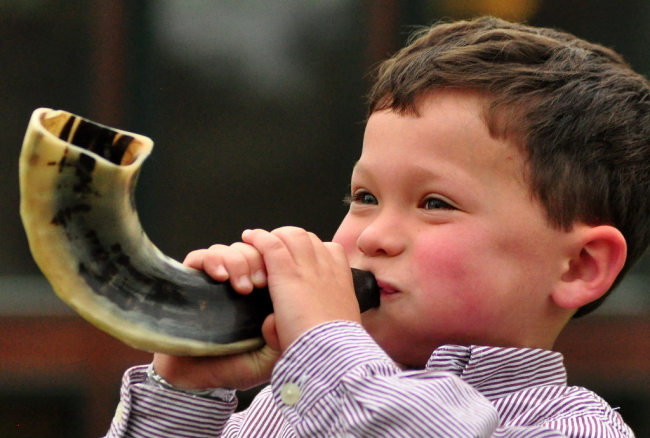SUNSET MONDAY, SEPTEMBER 6: Sound the shofar and wish your neighbor L’shanah tovah: “For a good year!” It’s Rosh Hashanah, the Jewish New Year—and it’s also the start of the High Holidays.
For two days, Jews around the world attend services, seek forgiveness and joyfully enter the annual High Holy Days. Sometimes called the Days of Awe, this period culminates in Yom Kippur, the solemn Day of Atonement, which starts at sunset on Wednesday, September 15 this year.
What are the High Holidays? Sometimes referred to as “High Holidays,” or “High Holy Days,” this is Rosh Hashanah and Yom Kippur and, often, the days in between the two holidays. One description of this period says, in essence, that G_d opens the books of judgment as the new year begins and finally, on Yom Kippur, the judgment for the year is “sealed.”
NEWS 2021: In light of the continued pandemic, many ask: Is it safe to attend Rosh Hashanah services this year? In this article, the Jewish Telegraphic Agency explores that question.
APPLES AND HONEY FOR A ‘SWEET’ NEW YEAR
For Rosh Hashanah, honey and apples are the most famous holiday foods in the United States; other foods, including dates and pomegranates, have ancient associations with the New Year and still are enjoyed in Jewish communities around the world. The honey-and-apples symbol, often seen on holiday cards and other Rosh Hashanah media, is a reminder of the joy in welcoming a “sweet” new year.
Literally “head of the year,” Rosh Hashanah was never referred to by name in the Bible. Instead, references in Leviticus were made to Yom Teruah, “the day of the sounding of the shofar.” In the synagogue, 100 notes are blown each day of the New Year festivities; some refer to this noise as a “call to repentance.” Traditionally, Jewish teaching associates Rosh Hashanah with the anniversary of the creation of Adam and Eve.
A lesser-known Jewish tradition related to Rosh Hashanah is tashlikh, or “casting off.” After filling their pockets—most often with small bits of bread—devotees walk to flowing water and empty their pockets, thereby symbolically “casting off” the sins of the old year.
Sweet recipes: Looking to bake up something sweet and scrumptious this Rosh Hashanah? Check out Chabad.org, AllRecipes, Epicurious, Food Network and Martha Stewart.
‘Trying Extra, Extra Hard to Get Along’
Every year, since its founding, ReadTheSpirit magazine has covered the Jewish High Holy Days. Central themes are taking stock of the previous year, reconciling broken relationships, asking forgiveness and preparing for a better new year. We asked Jewish scholar and contributing writer Joe Lewis to write about his reflections. Joe writes …
I’ve been reading one of the complicated medieval acrostic poems added to the “additional” liturgy for Yom Kippur. Many people know that Jewish tradition involves three daily liturgical units, with an extra one on special days such as holy days. The extra liturgical unit recalls the special sacrifices of a holy day in the time of the Temple.
On Yom Kippur, the extra liturgy includes several extra poems—extra extras.
One of the longest and most complicated of these recalls the special sacrifices of Yom Kippur as outlined in the Mishnah, the early compilation of Jewish law and tradition. Even if he knew his duties well, the High Priest had to take a week-long refresher course and practice, practice, practice for the rituals of this day, with its immersions and changes of clothing and the tricky balancing of a pan of glowing coals in one hand and a ladle of incense in the other. Don’t try this at home!
What you can do at home is, like me, refresh your understanding of the ingeniously elliptical Hebrew poetry.
You might think I’m one of those people who’d like to see the Temple rebuilt. In its time, it was a world-wide tourist destination and well worth a visit; and none of us knows how its rituals might stir modern skeptical religious natures. Some think its time will come again, soon. Others, though, consider all references to the sacrificial system—even the “additional” liturgy through which it is recalled—outdated, even distasteful or downright primitive. I’m neither of those.
For me, the Temple ritual symbolizes a way of connecting with the divine. I can mourn its loss, and like any mourner can dwell on every memory I can recover, without wishing for its return. What’s more, the loss of the Temple ritual is a valuable symbol in itself. Unlike the many tragic sufferings forced on the Jewish people throughout our long history, it’s one tragedy that (our sages taught) we brought upon ourselves through causeless hatred.
The weeks leading up to Yom Kippur are a time to make peace for offenses between people; then we can seek God’s forgiveness for our sins with hearts free of bitterness. Dwelling on the loss of our ancient form of prayer should remind us that unless we make peace—with our neighbor whose lawn sign offends us, with our more distant neighbors whose neighborhood we find unfamiliar and consider enviable or unsafe, with neighboring peoples whose intentions we fear and mistrust—we can lose all that we cherish.
There’s no better time to try extra, extra hard to get along with others!



Tell Us What You Think